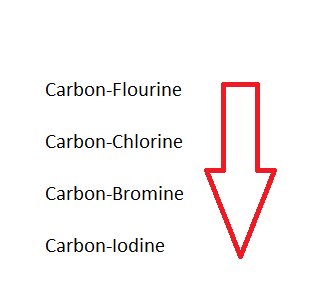Here are the boiling points of the halogenoalkanes of chlorides, bromides and iodides. Three of these boiling points are below room teperature, meaning they are gases. Whilst the rst are likely to be found as liquids. | Solubility in Water Halogenoalknanes are only slightly soluble in water. So in order for a halogenoalkane to dissolve in water, you have to break attractions between the halogenoalkane molecules (van der Waals dispersion and dipole-dipole interactions) and break the hydrogen bonds between water molecules. Both reactions require energy.
Solubility in organic solvents Halogenoalkanes tend to dissolve in organic solvents because the new intermolecular attractions have much the same strength as the ones being broken in the separate halogenoalkane and solvent. |
Bond Strength The four carbon-halogen bond strengths decrease from C-F to C-I, as the C-F bond is a lot stronger, as for a reaction to occur, the carbon-halogen bond must be broken. This gets easier as you go from fluorine to iodine, as the compounds get more reactive. Iodoalkanes are the most reactive and flouroalkanes the least. |
|
